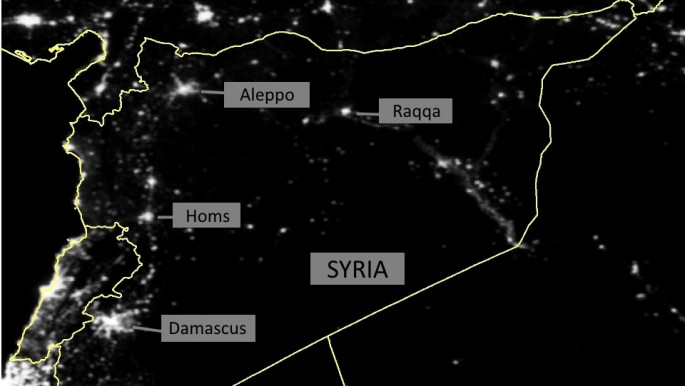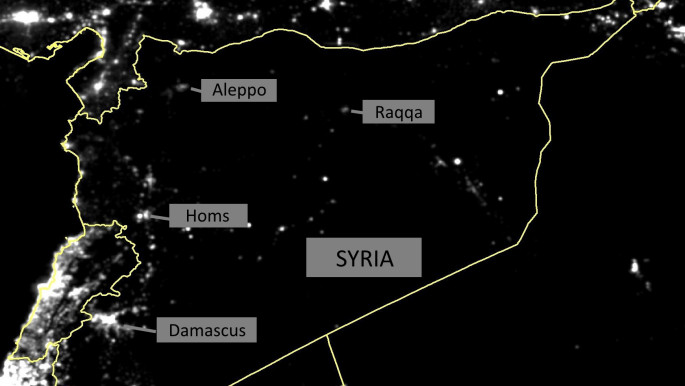Four years of war plunges Syria into darkness
Darkness envelopes Syria, both metaphorically and in reality.
Four years of war and destruction have extinguished some eighty-three percent of all the lights in the country.
Comparing night time images from space shows Aleppo has all but disappered from view through the course of the conflict.
Only three in every 100 lights in the city is still working.
 |
 |
|
"Satellite imagery is the most objective source of data showing the devastation of Syria on a national scale," said Dr Xi Li from Wuhan University in China and lead researcher on the project.
"Taken from 500 miles above the earth, these images help us understand the suffering and fear experienced by ordinary Syrians every day, as their country is destroyed around them."
The images have been released as part of the #WithSyria campaign, which is backed by more than 100 humanitarian and human rights organisations.
The analysis of satellite photos from the past four years reveals how different provinces have been affected to varying degrees.
| Syrian town | Percentage of lights out |
| Aleppo | 97 percent |
| Idlib | 96 percent |
| Raqqa | 96 percent |
| Deir ez-Zor | 90 percent |
| Latakia | 88 percent |
| Hama | 87 percent |
| Homs | 87 percent |
| Tartus | 87 percent |
| Suwayda | 80 percent |
| Rif Dimashq | 78 percent |
| Hasakah | 77 percent |
| Quneitra | 47 percent |
| Damascus | 33 percent |
Li has researched fluctuating light patterns in almost 160 countries, but nowhere else has he seen such a dramatic decline in night-time light, except during the genocide in Rwanda where 80 percent of lights went out in just a few
Failed resolutions
In 2014, the UN Security Council adopted three resolutions that demanded action to secure protection and assistance for civilians in Syria. Since then, more than 15,000 civilians have been killed, many of them children.
Access to relief has not improved and humanitarian funding has fallen compared with the needs required.
A new report, Failing Syria, released today by more than 20 international NGOs accuses warring parties and powerful states of failing to achieve what these resolutions set out to do.
The Failing Syria report states:
- People are not protected. 2014 was the deadliest year of the conflict in Syria, with at least 76,000 Syrians killed.
- Humanitarian needs have increased by nearly a third compared with 2013, with 5.6 million children now in need of aid.
- More than 11.6 million people are now in urgent need of clean water and nearly ten million people do not have enough to eat.
- Humanitarian support has not matched the rise in needs. In 2013, 71 percent of the funds needed to support civilians inside Syria and refugees in neighbouring countries were provided. In 2014, this had dropped to 57 percent.
- Aid access has not improved. More than 212,000 people are still living in besieged locations and at least 4.8 million reside in areas that aid agencies operating from inside Syria can either reach only sporadically or in many locations not at all.
|
|
||
| Watch 'Afraid of the Dark' - produced by the #WithSyria campaign |
"2014 was the darkest year yet in this horrific war," said Jan Egeland, the secretary-general of the Norwegian Refugee Council and a former United Nations undersecretary-general for humanitarian affairs.
"Civilians are not protected as the Security Council promised they would be, their access to relief has not improved and humanitarian funding is declining compared to the needs. It is an outrage how we are failing Syrians."
More than 200,000 people killed since 2011, with 10 million people fleeing their homes, three million Syrian children no longer in school and the average life expectancy fallen by two decades.
The medical system across much of the country has also imploded.
"The health system in Syria has been devastated by the ongoing conflict, and accessing essential medical treatment is almost impossible," warned Medicins Sans Frontieres (MSF).
From an estimated 2,500 doctors who worked in the Syrian city of Aleppo, fewer than 100 work in hospitals still operating in the city. The rest have fled, become internally displaced, or have been kidnapped or killed.
MSF, known for operating in severely hazardous environments and warzones, have themselves had to scale back their operations to shore up the broken medical infrastructure due to security concerns after the Islamic State group abducted five of its staff in January 2014.







